What is periodontal disease?
Periodontal disease affects the gums and bone supporting the teeth. You may have it and not even know it. There are no early warning signs, except for occasional bleeding and redness around the gums when brushing, and mouth odor. However, as the disease progresses, the symptoms become more obvious. If left untreated, periodontal disease can lead to loosing of teeth, receding gums, and gum discomfort.
Gums separate from teeth, forming a periodontal pocket. Healing is complete. Periodontal pocket is reduced, and new healthy tissue supports tooth.
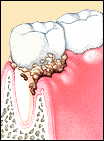
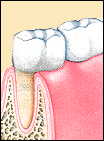
What causes periodontal disease?
Bacteria are the primary cause of periodontal infection. Bacteria form in plaque, which is sticky, almost invisible film that forms over the teeth and destroys bone. Plaque that is not removed by regular brushing and flossing hardens into tartar over time. You cannot remove tartar (or calculus) on your own. The only way to remove tartar is by a procedure called scaling, which is done by a dentist.
Plaque that should have been removed by brushing or flossing
has now become calculus,which you cannot remove yourself.

What are the stages of periodontal disease?
Stage 1. Gingivitis.
In this early stage, your gums may look normal but they also may be red, puffy, and bleed easily when you brush your teeth. You also may notice some mouth odor. This is because bacteria in plaque have caused infection.
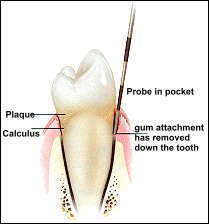
Stage 2. Early Periodontitis.
Early periodontitis occurs when the bacterial infection spreads from the gum to the bone that supports the teeth. The bacteria then cause small spaces, or crevices, to form between the gums. These crevices are called pockets. They are deeper than normal spaces, which measures to 1 to 3 mm deep. Bacteria in the pocket also can destroy some bone. As the pocket grows and the amount of bacteria increases, the gums recede down the root of the tooth, increasing the pocket depth. Your dentist measure how deep your pocket is with an instrument called a periodontal probe, which is placed in the gum crevice.
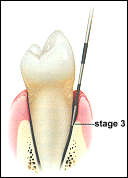
Stage 3. Moderate Periodontitis.
When the gum has crept further down the root, it is called moderate periodontitis. In this stage, up to one-third of your bone has been lost.
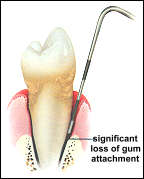
Stage 4. Advanced Periodontitis.
When half or more of the original bone holding the tooth has been lost, and pockets are very deep, it is called advanced periodontitis. The tooth may appear longer because the root is exposed, and the tooth may loosen and eventually fall out, or have to be removed by your dentist.
What you and we can do to treat and prevent periodontitis
Periodontal disease may be prevented if you brush and floss every day to remove bacterial plaque and get regular dental checkups.
If you do have periodontal disease, we will normally remove the calculus above and below the gum. This procedure is called scaling. In moderate or severe periodontitis, it may be necessary to smooth the surface of the teeth. This procedure, is called root planing. removes residual calculus and bacterial by-products. We may also replace old crowns and fillings that no longer fit well because these trap bacteria and food that can cause severe periodontal problems.
|